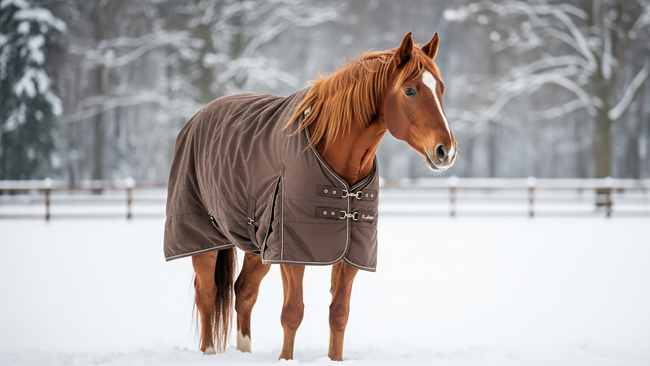
Do you need to blanket your horse? In most cases, the answer is no because the horse makes his own blanket, a hair coat that is long enough and thick enough to hold up to the coldest days of winter. It’s a blanket that flattens or stands above the skin as the horse grows warmer or cooler. Hair is a great insulator, and it fluffs up to warm the horse. Heat rising from the body warms the air that that is trapped between the hairs.
Should you blanket your horse? This answer could be yes or no. The circumstances of each horse help to make up this answer. Clipped horses are not able to create their own blanket of hair so the owner must take the time to blanket the horse as the temperatures change. Older horses whose appetites and digestion may not provide enough fuel to keep their flesh full and their “furnaces” strong require shelter or blanketing during bad weather. What must be considered is the type of weather the horse is subject too. Cold wind causes horses the greatest discomfort and more rapidly drains their energy because it whips away body heat faster than any other condition. Cold rain is a close second, chilling the skin through conduction and flattening of the hairs’ insulating lift. Thirty-five degrees and rain is much harder on a horse than dry weather that is below zero.
Do you ride your horse during the cold months? If you do, blanketing can help to keep their coat clean and prevent their skin from becoming irritated. Blankets can also help prevent your horses’ winter coat from getting too long. A long winter coat will make them warm during exercising. If you don’t have the time to completely cool them out after cold weather riding, blanketing them to keep their winter coat shorter is a possible help. To speed up the drying process you can rub him down with a dry towel. Perhaps cover the cooling horse as you walk him with a cooler that draws moisture away from his hair where it then evaporates.
Keep in mind that there can be a substantial time commitment that goes with blanketing and unblanketing a horse each day. If your horse is cold, blanketing may be the best option, but even if you do decide to blanket your horse, don’t start too early. Allow them to adjust to the colder weather. Then before the real cold sets in, put them in a midweight blanket that will help prevent them from growing a thick coat. The wise choice is to begin nighttime blanketing with a light cover when overnight temperatures hit 50 degrees or less. Anytime it gets down to the low 40s, especially if you have a major daily temperature fluctuation, it’s a good time to start blanketing. However, be certain you have a plan for blanket removal or change when the daily temperature rises.


Comment here